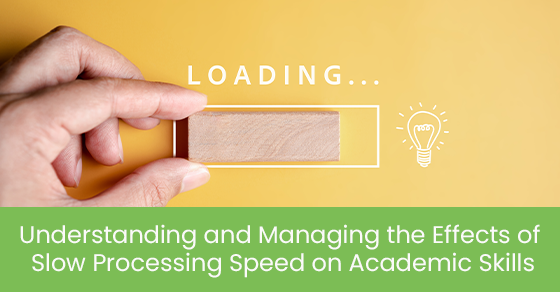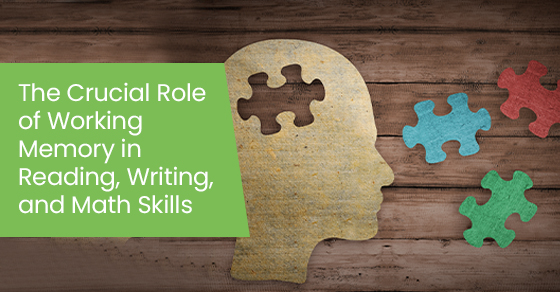“Can you speed it up a little, honey? Maybe go a bit faster?”
Does that sound like part of the daily conversation between you and your child?
Students who seem to take an inordinate amount of time completing assignments, getting ready to go anywhere, responding when spoken to, or making their way through a book are frequently labeled as unmotivated, sleepy, or lazy, when in fact they have a weakness in processing speed.
What Is Processing Speed?
Processing speed is a fundamental cognitive function that plays a crucial role in important academic activities such as reading, writing, and math and can also affect social interactions. The term refers to the ability to quickly and efficiently perceive information, process it, and respond in a timely manner—it’s the rate at which the brain accepts and understands the input it receives. A common analogy is that of a computer processor: some operate at high speeds, enabling quick data retrieval and execution, while others may function more slowly, leading to delays.
When you receive information, such as while watching a movie or hearing a friend’s voice, several steps take place in your brain:
Reception: Your senses, like your eyes or ears, detect the information and convert it into signals that your brain can understand.
Transmission: These signals travel as electrical impulses through networks of neurons (brain cells) in your brain.
Integration: Neurons communicate with each other through synapses, which are the tiny gaps between them. Chemical messengers called neurotransmitters help transmit signals from one neuron to the next.
Processing: Your brain processes this information by interpreting patterns, recognizing familiar objects or sounds, and associating them with memories or emotions.
Storage: Important information is moved to various parts of the brain for future use. Memories, for example, are formed through the strengthening of connections between neurons.
Response: Based on the processed information, your brain sends signals to different parts of your body to generate a response, such as moving your hand away from a hot stove or laughing at a joke.
But things can get bogged down.
When our senses don’t accurately capture the information, the initial input can be faulty. This might happen, for example, if your eyes don’t focus properly, or you have difficulty hearing. Problems can arise if there are interruptions or delays in the transmission of signals between neurons, which can occur when there is damage to the neurons or if there are disruptions in the release of neurotransmitters. If the synapses between neurons aren’t functioning optimally, the integration of information can be compromised. This might occur if there’s a shortage of neurotransmitters or if there’s interference in the chemical or electrical signals between neurons. The brain might also struggle to process information efficiently if there are issues with the neural networks responsible for pattern recognition, memory retrieval, or other cognitive functions. And if the storage and retrieval of information are impaired, a person can have difficulty accessing memories or forming new ones.
Evidence-Based Connections
According to a recent paper published in the journal Child Neuropsychology by G.A. Forchelli et al. (2021), In a research sample of children with high-functioning autism spectrum disorder, children with slower processing speed demonstrated significantly increased social communication and adaptive problems, as rated on behavioural rating scales (Oliveras et al., 2012). Slower processing speed has also been shown to increase social difficulties in children with inattention symptoms and ADHD (Thorsen et al., 2018). Additionally, research has also linked processing speed weakness to academic outcomes. In a study by Braaten et al. (2020), processing speed weaknesses had a negative effect on both math and reading achievement in children. Similarly, in a study exploring the relationship between processing speed and symptoms of “sluggish cognitive tempo” in children with ADHD, a processing speed weakness predicted lower academic achievement outcomes (Cook et al., 2019). These investigations suggest adaptive, social, and academic implications for processing speed weakness.
Effects on Academic Skills
For students with slow processing speed, reading can become a laborious task. They may struggle to decode words, leading to difficulties in comprehension and a slower overall reading pace. As a result, they may find it challenging to keep up with assignments or complete readings within given time frames and may experience frustration or fatigue.
Similarly, a processing speed deficit can affect writing skills. Students may take longer to generate ideas, organize their thoughts, and translate them into written words. This can hinder both the quantity and quality of their written work, affecting performance on essays, reports, and other written assignments.
In math, the quick and accurate processing of numerical information is vital. Students with impaired processing speed may face difficulties in completing timed math assessments, solving problems (especially those with written instructions or descriptions), and accurately executing multi-step calculations. This can erode their confidence in the subject and hinder their overall performance.
Strategies for Overcoming Slow Processing Speed
Extended Time: Giving students more time for reading assignments, tests, and writing tasks can alleviate the pressure associated with time constraints.
Chunk Things Up: Break larger tasks into smaller, more manageable steps. This can help students focus on one component at a time, reducing the cognitive load.
Use Visual Aids: Incorporate visual aids, such as graphic organizers, charts, and diagrams, into instruction to enhance understanding and facilitate quicker processing of information.
Encourage Multisensory Learning: Engage multiple senses in the learning process. For instance, incorporate hands-on activities, movement, or verbal repetition to reinforce concepts.
Promote Self-Advocacy: Teach students to recognize their strengths and challenges and advocate for accommodations when needed. This skill is valuable for their academic and personal development.
Understanding the effects of slow processing speed on academic skills is crucial for educators, parents, and students alike. By implementing targeted strategies and fostering a supportive learning environment, we can empower students to overcome these challenges, build confidence, and achieve academic success. At Evoke Learning, our strategists work with students who struggle with processing deficits to help them develop and apply helpful tactics and identify the accommodations that work best for them. Contact us to learn more about our programs and services.
For a deeper dive into the topic of processing speed, these books may be helpful:
Bright Kids Who Can’t Keep Up: Help Your Child Overcome Slow Processing Speed and Succeed in a Fast-Paced World by Ellen Braaten and Brian Willoughby
For parents of students ages 5–18, this guide offers clear explanations, helpful tools, advice on accommodations, information on what to expect during diagnostic testing, and ways to support students’ social and emotional well-being.
Smart but Scattered by Peg Dawson, EdD, and Richard Guare, PhD
The authors provide practical strategies to help children and teens develop executive skills, which can indirectly support processing speed challenges.
The Power of Different by Gail Saltz, MD
This book explores the link between neurological differences (including processing speed) and success. It also offers insights into how to harness unique cognitive strengths.



